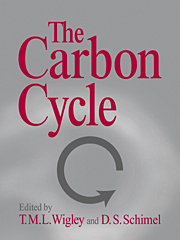Book contents
- Frontmatter
- Contents
- Preface
- Acknowledgments
- Contributors to the 1993 Global Change Institute
- I INTRODUCTION
- II THE MISSING CARBON SINK
- III PALEO-CO2 VARIATIONS
- 12 Isotope and Carbon Cycle Inferences
- 13 Shallow Water Carbonate Deposition and Its Effect on the Carbon Cycle
- IV MODELING CO2 CHANGES
- Part V Appendixes
- Index
12 - Isotope and Carbon Cycle Inferences
from III - PALEO-CO2 VARIATIONS
Published online by Cambridge University Press: 04 December 2009
- Frontmatter
- Contents
- Preface
- Acknowledgments
- Contributors to the 1993 Global Change Institute
- I INTRODUCTION
- II THE MISSING CARBON SINK
- III PALEO-CO2 VARIATIONS
- 12 Isotope and Carbon Cycle Inferences
- 13 Shallow Water Carbonate Deposition and Its Effect on the Carbon Cycle
- IV MODELING CO2 CHANGES
- Part V Appendixes
- Index
Summary
Abstract
Various applications of carbon isotope (13C and 14C) records are described. The main data sources are dendrochronologically dated tree rings, ice cores, and ocean sediments (including corals). The representativeness and characteristics of these records are discussed. The history of atmospheric 14C changes is determined by changes in oceanic upwelling rate and by solar and geomagnetic influences on upper atmosphere production rate. Separating these causal factors from the record is difficult, but analyses suggest interesting cyclic changes in North Atlantic deep water formation rates (periodicity around 500 years) and solar output (periodicity around 200 years). Isotopic data have provided valuable oceanic information regarding the current atmosphere-to-ocean flux of CO2, deep water residence times, current upwelling rates, and glacial/interglacial changes in upwelling rate. This work is discussed and evaluated. Finally, the problems involved in interpreting radiocarbon dates in terms of calibrated (i.e., estimated calendar) dates are illustrated using the dating of the Mazama (U.S. Pacific Northwest) eruption as an example.
Introduction
Natural carbon contains the three carbon isotopes 12C, 13C, and 14C. Of these isotopes, 12C is by far the most abundant at 98.9% of total carbon. Thus, the carbon cycle in nature is essentially a 12C cycle, with 13C (1.1%) and 14C (10–10%) contributing only minor amounts. Nevertheless, 13C and 14C play a major role as tracers through which information on the physical and chemical properties of the carbon cycle can be obtained.
- Type
- Chapter
- Information
- The Carbon Cycle , pp. 153 - 160Publisher: Cambridge University PressPrint publication year: 2000
- 1
- Cited by



